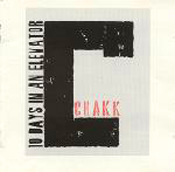 A recent TED presentation saw Sarah Angliss examine the connection between Britain’s Industrial Revolution and Detroit’s motor industry, and the music they have produced. In the reflections of unforgiving industrial environments, she can see an ‘art out of noise’ model at work.
A recent TED presentation saw Sarah Angliss examine the connection between Britain’s Industrial Revolution and Detroit’s motor industry, and the music they have produced. In the reflections of unforgiving industrial environments, she can see an ‘art out of noise’ model at work.
Curiously, I’ve drawn exactly the opposite conclusion over the way modern businesses have turned music back into industrial noise.
As Spacedog, Sarah plays on her training in electroacoustics, music and robotics to make her own brand of electronic music with ‘curious or vintage sound equipment and little known stories from the history of science’. She refers to the resilience of human creativity and ‘its ability to make something astounding and compelling even in the most alienating of situations’.

An offshoot of the US TED (technology, entertainment, design) programme, she took the stage at TEDxBrighton to offer her interpretation of the collision of art and noise, and the human spirit.
She chose the drum machine to illustrate the reception that was awaiting more modern ‘music machines’, with the Wurlitzer Sideman being featured in the November 1960 issue of Popular Mechanics – not much concession to ‘art’ here, especially for the Musicians’ Union.
Having dismissed the first drum machine as a ‘stilted and unimaginative performer’, the UK Musicians’ Union also chose to view the first talking pictures as ‘a dehumanised form of entertainment’ – a judgement driven by large numbers of accompanists made redundant when their services were no longer required. Absurdly, the MU argued that talkies replaced human performance with mechanical performance – in this case, recorded dialogue.
To be fair, the MU has been commendably consistent in its ability to justify its Luddite approach to the evolution of musical instruments.
Construction time again
Sarah offered a fantastic precedent to Kraftwerk’s celebrated take on machines and music, pointing out that the clog dances devised in the cotton mills of Lancashire (during the 18th and 19th century Industrial Revolution) set a precedent for the Kling Klang Studio agenda in Düsseldorf. By implication, then, the whole of the industrial music movement – whether you’re talking Stockhausen, Berlin’s Einstürzende Neubaten, Sydney’s SPK or Sheffield’s Chakk – was pre-empted by a bunch of factory workers whose rights and senses were under assault.
 Detroit spawned techno in the 1980s, with Juan Atkins, Derrick May and Kevin Saunderson adapting the industrial agenda to reflect the fortunes of America’s Motortown. And redirecting the dance music express in the process. This time, technology took a look backwards, as techno preferred analogue drum machines and synthesisers to the new wave of digital instruments, but the spirit was the same as that of those clog dancers.
Detroit spawned techno in the 1980s, with Juan Atkins, Derrick May and Kevin Saunderson adapting the industrial agenda to reflect the fortunes of America’s Motortown. And redirecting the dance music express in the process. This time, technology took a look backwards, as techno preferred analogue drum machines and synthesisers to the new wave of digital instruments, but the spirit was the same as that of those clog dancers.
But having wrung music out of industrial noise, we are now manufacturing noise pollution from music. So much for human resilience and musical progress.
We have muzak spilling onto the streets, distorted switchboard ‘hold’ music reviving IPCRESS conditioning and MP3’s death rattle reverberating around every public space. If we can class shopping malls, hotel lobbies and public transport as places of industry, we have a whole new take on industrial noise.
If you have any doubts that the carpet bombing approach adopted by so many shops and hospitality outlets is a grave marketing mistake, look no further than Satellite Music Australia (SMA), a company that has been supplying Australian and New Zealand retail, hospitality and commercial businesses with audio, vision and marketing solutions for 15 years.
Retail therapy
‘In 1980 we were sending out 90-minute cassette tapes,’ SMA MD, Rick Solomon, told me. ‘It was a great selection of music but after you’ve heard it three times you’re ready for something else. And it wasn’t giving people the atmosphere they needed in their shop. Even if we sent the right selection of tapes, we were relying on people to use it correctly.’
 SMA turned to the University of Sydney for some serious research.
SMA turned to the University of Sydney for some serious research.
‘The research shows that at different times of the day you get different kinds of customer. The variations – tempo rates and so on – that we can put into the music have an absolute effect on what you are trying to achieve as a retailer, in hospitality or whatever,’ Solomon says. ‘If you run a restaurant, at the start of lunch you want the turns to happen quickly, so you up the tempo. After that lunchtime rush is over, you want people to stay a little bit longer, so we lower the tempo.
‘We’re trying desperately to take the randomness out of this business,’ he explains. ‘If you go into a pub and the music is wrong, you’ll be out of there. We’re not trying to do music that everyone likes because there is no music that everyone likes, but for the demographic and the customer profile you are trying to target, we will hit the highest proportion.’
In spite of SMA’s efforts to rescue the situation, for most of us the assault goes on, with music spilling onto the streets, into our conversations, over our drinks and meals…
Back at TED, Sarah reckons that we are now living in ‘the era of transmitted music, where live music is a treat’. I’d go further – I’d say we’re turning music into a level of pollution that even AC/DC would disown.

